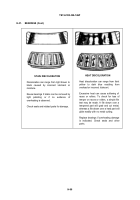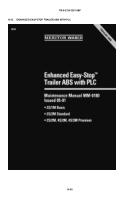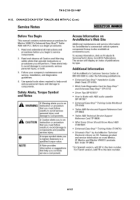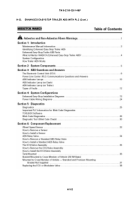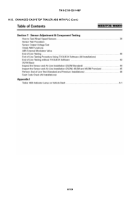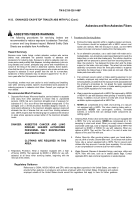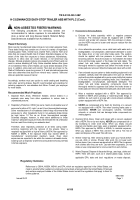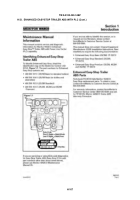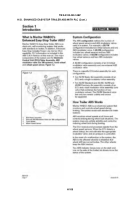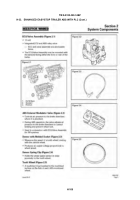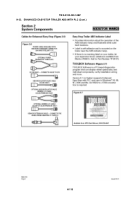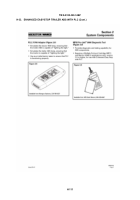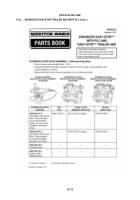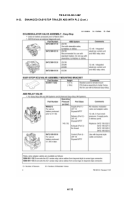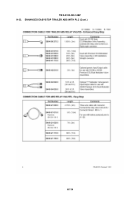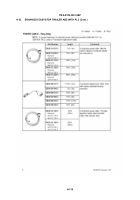TM-9-2330-326-14-P - Page 360 of 540
TM 9-2330-326-14&P
H
-
106
H-33.ENHANCED EASY-STOP TRAILER ABS WITH PLC (Cont.)
NON-ASBESTOS FIBERS WARNING:
The
following
procedures
for
servicing
brakes
are
recommended to reduce exposure to non-asbestos ?ber
dust, a cancer and lung disease hazard. Material Safety
Data Sheets are available from ArvinMeritor.
Hazard Summary
Most recently manufactured brake linings do not contain asbestos ?bers.
These brake linings may contain one or more of a variety of ingredients,
including glass ?bers, mineral wool, aramid ?bers, ceramic ?bers and
silica that can present health risks if inhaled. Scientists disagree on the
extent of the risks from exposure to these substances. Nonetheless,
exposure to silica dust can cause silicosis, a non-cancerous lung
disease. Silicosis gradually reduces lung capacity and ef?ciency and can
result in serious breathing dif ?culty. Some scientists believe other types
of non-asbestos ?bers, when inhaled, can cause similar diseases of the
lung. In addition, silica dust and ceramic ?ber dust are known to the
State of California to cause lung cancer. U.S. and international agencies
have also determined that dust from mineral wool, ceramic ?bers and
silica are potential causes of cancer.
Accordingly, workers must use caution to avoid creating and breathing
dust when servicing brakes. Speci?c recommended work practices for
reducing exposure to non-asbestos dust follow. Consult your employer
for more details.
Recommended Work Practices
1. Separate Work Areas. Whenever feasible, service brakes in a
separate area away from other operations to reduce risks to
unprotected persons.
2. Respiratory Protection. OSHA has set a maximum allowable level of
exposure for silica of 0.1 mg/m
3
as an 8-hour time-weighted average.
Some manufacturers of non-asbestos brake linings recommend that
exposures to other ingredients found in non-asbestos brake linings
be kept below 1.0 f/cc as an 8-hour time-weighted average.
Scientists disagree, however, to what extent adherence to these
maximum allowable exposure levels will eliminate the risk of disease
that can result from inhaling non-asbestos dust.
Therefore, wear respiratory protection at all times during brake
servicing, beginning with the removal of the wheels. Wear a
respirator equipped with a high-ef?ciency (HEPA) ?lter approved by
NIOSH or MSHA, if the exposure levels may exceed OSHA or
manufacturers’
recommended
maximum
levels.
Even
when
exposures are expected to be within the maximum allowable levels,
wearing such a respirator at all times during brake servicing will help
minimize exposure.
3. Procedures for Servicing Brakes.
a. Enclose
the
brake
assembly
within
a
negative
pressure
enclosure. The enclosure should be equipped with a HEPA
vacuum and worker arm sleeves. With the enclosure in place,
use the HEPA vacuum to loosen and vacuum residue from the
brake parts.
b. As an alternative procedure, use a catch basin with water and a
biodegradable, non-phosphate, water-based detergent to wash
the brake drum or rotor and other brake parts. The solution
should be applied with low pressure to prevent dust from
becoming airborne. Allow the solution to ?ow between the brake
drum and the brake support or the brake rotor and caliper. The
wheel
hub
and
brake assembly
components
should
be
thoroughly wetted to suppress dust before the brake shoes or
brake pads are removed. Wipe the brake parts clean with a cloth.
c. If an enclosed vacuum system or brake washing equipment is not
available, carefully clean the brake parts in the open air. Wet the
parts with a solution applied with a pump-spray bottle that creates
a ?ne mist. Use a solution containing water, and, if available, a
biodegradable,
non-phosphate, water-based
detergent.
The
wheel
hub
and
brake
assembly components
should
be
thoroughly wetted to suppress dust before the brake shoes or
brake pads are removed. Wipe the brake parts clean with a cloth.
d. Wear a respirator equipped with a HEPA ?lter approved by
NIOSH or MSHA when grinding or machining brake linings. In
addition, do such work in an area with a local exhaust ventilation
system equipped with a HEPA ?lter.
e.
NEVER
use compressed air by itself, dry brushing, or a vacuum
not equipped with a HEPA ?lter when cleaning brake parts or
assemblies.
NEVER
use
carcinogenic
solvents, ?ammable
solvents, or solvents that can damage brake components as
wetting agents.
4. Cleaning Work Areas. Clean work areas with a vacuum equipped
with a HEPA ?lter or by wet wiping.
NEVER
use compressed air or
dry sweeping to clean work areas. When you empty vacuum
cleaners and handle used rags, wear a respirator equipped with a
HEPA ?lter approved by NIOSH or MSHA, to minimize exposure.
When you replace a HEPA ?lter, wet the ?lter with a ?ne mist of
water and dispose of the used ?lter with care.
5. Worker Clean-Up. After servicing brakes, wash your hands before
you eat, drink or smoke. Shower after work. Do not wear work
clothes home. Use a vacuum equipped with a HEPA ?lter to vacuum
work clothes after they are worn. Launder them separately. Do not
shake or use compressed air to remove dust from work clothes.
6. Waste Disposal
.
Dispose of discarded linings, used rags, cloths and
HEPA ?lters with care, such as in sealed plastic bags. Consult
applicable EPA, state and local regulations on waste disposal
.
Regulatory Guidance
References to OSHA, NIOSH, MSHA, and EPA, which are regulatory agencies in the United States, are
made to provide further guidance to employers and workers employed within the United States. Employers
and workers employed outside of the United States should consult the regulations that apply to them for
further guidance.
MM-0180
Issued 05-01
Page 1
Back to Top

